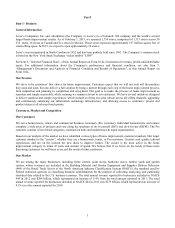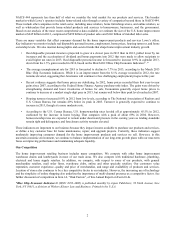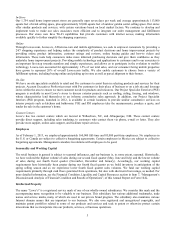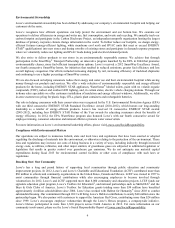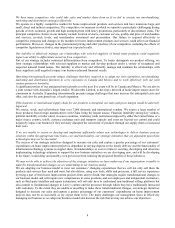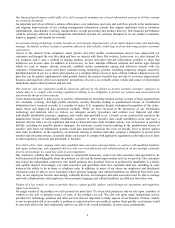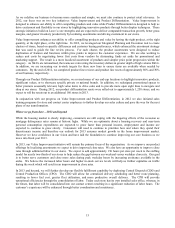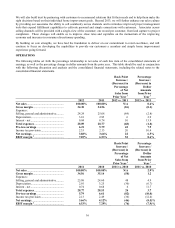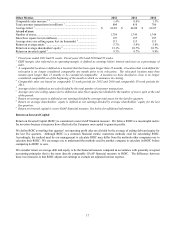Lowe's 2012 Annual Report Download - page 23
Download and view the complete annual report
Please find page 23 of the 2012 Lowe's annual report below. You can navigate through the pages in the report by either clicking on the pages listed below, or by using the keyword search tool below to find specific information within the annual report.9
Our financial performance could suffer if we fail to properly maintain our critical information systems or if those systems
are seriously disrupted.
An important part of our efforts to achieve efficiencies, cost reductions, and sales and cash flow growth is the maintenance
and ongoing improvements of our existing management information systems that support operations such as inventory
replenishment, merchandise ordering, transportation, receipt processing and product delivery. Our financial performance
could be adversely affected if our management information systems are seriously disrupted or we are unable to maintain,
improve, upgrade, and expand our systems.
As customer-facing technology systems become an increasingly important part of our multi-channel sales and marketing
strategy, the failure of those systems to perform effectively and reliably could keep us from delivering positive customer
experiences.
Access to the internet from computers, smart phones and other mobile communication devices has empowered our
customers and changed the way they shop and how we interact with them. Our website, Lowes.com, is a sales channel for
our products, and is also a method of making product, project and other relevant information available to them that
influences our in-store sales. In addition to Lowes.com, we have multiple affiliated websites and mobile apps through
which we seek to inspire, inform, cross-sell, establish online communities among and otherwise interact with our
customers. Performance issues with these customer-facing technology systems, including temporary outages caused by
distributed denial of service or other cyber-attacks, or a complete failure of one or more of them without a disaster recovery
plan that can be quickly implemented could quickly destroy the positive benefits they provide to our home improvement
business and negatively affect our customers’ perceptions of Lowe’s as a reliable online vendor and source of information
about home improvement products and services.
Our business and our reputation could be adversely affected by the failure to protect sensitive customer, employee or
vendor data or to comply with evolving regulations relating to our obligation to protect our systems and assets and such
data from the threat of cyber-attacks.
Cyber-attacks designed to gain access to sensitive information by breaching mission critical systems of large organizations
are constantly evolving, and high profile electronic security breaches leading to unauthorized release of confidential
information have occurred recently at a number of major U.S. companies despite widespread recognition of the cyber-
attack threat and improved data protection methods. While we have invested in the protection of our information
technology and maintain what we believe are adequate security procedures and controls over financial and other
individually identifiable customer, employee and vendor data provided to us, a breach in our systems that results in the
unauthorized release of individually identifiable customer or other sensitive data could nonetheless occur and have a
material adverse effect on our reputation and lead to financial losses from remedial actions, loss of business or potential
liability, including for possible punitive damages. An electronic security breach resulting in the unauthorized release of
sensitive data from our information systems could also materially increase the costs we already incur to protect against
such risks. In addition, as the regulatory environment relating to retailers and other company’s obligation to protect such
sensitive data becomes stricter, a material failure on our part to comply with applicable regulations could subject us to fines
or other regulatory sanctions and potentially to lawsuits.
If we fail to hire, train, manage and retain qualified sales associates and specialists, or contract with qualified installers
and repair technicians, with expanded skill sets who can work effectively and collaboratively in an increasingly culturally
diverse environment, we could lose sales to our competitors.
Our customers, whether they are homeowners or commercial businesses, expect our sales associates and specialists to be
well trained and knowledgeable about the products we sell and the home improvement services we provide. Our customers
also expect the independent contractors who install products they purchase from us to perform the installation in a timely
and capable manner. Increasingly, our sales associates and specialists must have expanded skill sets, including in some
instances the ability to do in-home or telephone sales. In addition, in many of our stores our employees and third-party
contractors must be able to serve customers whose primary language and cultural traditions are different from their own.
Also, as our employees become increasingly culturally diverse, our managers and sales associates must be able to manage
and work collaboratively with employees whose primary language and cultural traditions are different from their own.
Failure of a key vendor or service provider that we cannot quickly replace could disrupt our operations and negatively
impact our business.
No single vendor of the products we sell accounts for more than 7% of our total purchases, but we rely upon a number of
vendors as the sole or primary source of some of the products we sell. We also rely upon many independent service
providers for technology solutions and other services that are important to many aspects of our business. If these vendors
or service providers fail or are unable to perform as expected and we are unable to replace them quickly, our business could
be adversely affected at least temporarily until we are able to do so and potentially, in some cases, permanently.




